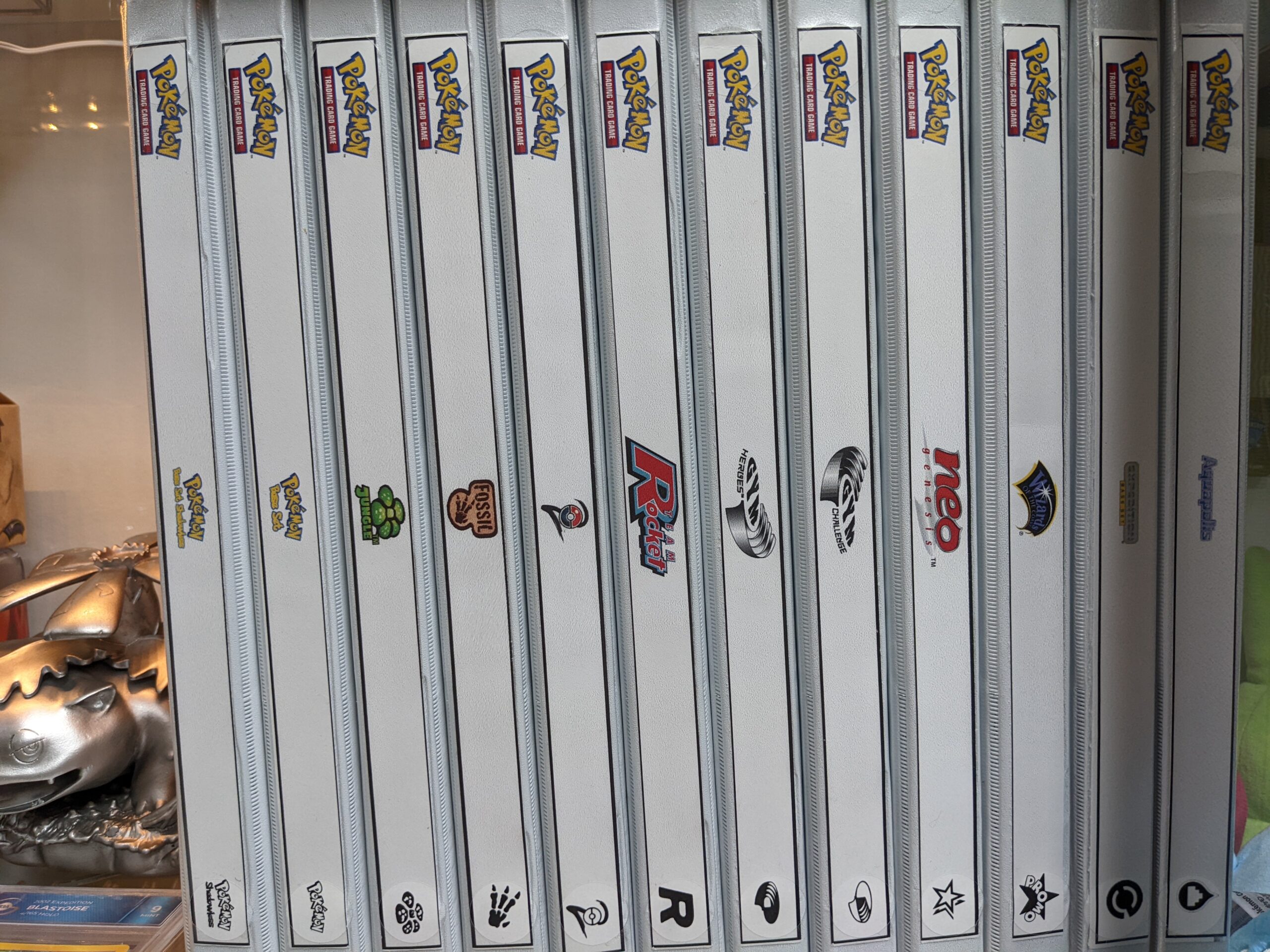Latest posts by Tony Bresnen, Pokémon Collector Supreme (see all)
- Every Pokemon Remake Ranked - November 6, 2022
- Pokepaste Guide - September 11, 2022
- All Pokemon Mega Evolutions Ranked - August 23, 2022
Table of Contents
- Bottom Line Up Front
- Selecting the Right Binder for You
- Binders, Binders Everywhere
- The Best Pokemon Card Binders
- Three-Ring Binders—the Affordable Workhorse
- Miniature Pocket Binders—Fun-Sized Options for the Road
- Oversized Card Binders—Specialty Binders for Unique Cards
- Side-Load Binders—the Modern Favorite
- Displaying Card Binders
- FAQs
- Conclusion—Protect Your Cards!

Bottom Line Up Front
Binders protect cards from many sources of damage, such as water, sunlight, dust, and overhandling. There isn’t a wrong binder to choose from, but there are approaches you can take to ensure your cards are protected for years to come. My favorite binders are the small, 1/2″ three-ring binders that I can label and organize for my displays. They are relatively cheap and are perfect for holding specific sets of cards.Selecting the Right Binder for You
When selecting binders, here are some things that I consider before making a purchase:- Storage space. Does the binder have enough pages to fit all the cards you want to store? Is there room in the binder for more cards to add in the future?
- Function. Is the binder sturdy? Can I handle it without worry?
- Aesthetics. Is the binder the right fit for my Pokémon display?
- Price. Can I afford this binder and others like it, or is there a cheaper option to consider?
Binders, Binders Everywhere
If you were a 90s kid like me, you probably had more than a few three-ring binders for your grade school classes. Notebook paper and hole-punched assignments made their way into the binders. At some point, I took an extra school binder I didn’t need for class and converted it into my first Pokémon card binder. Before I had a binder, most of my Pokémon cards were in a couple of stacks on top of my dresser. I shudder to think about the tragedies that nearly claimed my stacks of cards during that time. But luckily, most escaped free of damage and were protected once in the binder. The first binder pages I had were sports card pages that didn’t fit Pokémon cards particularly well, but they did the job well enough. From these early years of collecting, much has changed. Today, binders of all sizes, binding types, shapes, and colors can be found specifically made for Pokémon cards. Once upon a time, the options for card storage were solid-color three-ring binders or nothing at all. Over the years, companies realized there was a market for selling quality card storage products. Many options now exist for storing Pokémon cards, and just because three-ring binders are the old guard doesn’t mean they don’t have their place in modern collections.The Best Pokemon Card Binders
Three-Ring Binders—the Affordable Workhorse

Pros
- Cheaper compared to some other alternatives
- Come in several thicknesses
- Usually have hardcovers for added protection
Cons
- Have to purchase pages for these binders
- Rings can become wrapped over time
- If not stored properly, it can damage cards


Miniature Pocket Binders—Fun-Sized Options for the Road

Pros
- The best option for traveling with a small set of cards
- Can flip through pages quickly
Cons
- Easily lost as the binder is very small
- Soft covers provide less protection to the cards
- You can only view 1 or 2 cards at a time

Oversized Card Binders—Specialty Binders for Unique Cards

Pros
- The best way to store oversized promo cards
- Binders are sturdy and offer adequate protection
Cons
- Can only view 1 or 2 cards at a time
- Not many varieties made other than official Pokémon products


Side-Load Binders—the Modern Favorite

Pros
- Usually well made
- Offer the best protection from dust
- Stylish covers and card backing add to their visual appeal
Cons
- Generally more expensive than other binder options
- Limited (fixed) number of binder binders that cannot be increased
- Soft covers offer less protection to cards


Displaying Card Binders
It’s tricky to display card binders. Most of them look the best from the front due to their design, but displaying them this way is difficult—how many books in your home are displayed with the front facing forward? Sideways or flat are the most popular options. Sideways is my preference, as it allows you to display or store as many as you want since this option takes up the least amount of space. It also means you can grab the binder with a finger and pull it out, avoiding any of the cards within the binder. I used to display more of my binders flat. I discovered that as my collection grew, my binders got too heavy and were too heavy to place on another full binder. This option could work if you have binders with thick covers that aren’t filled to the brim with cards. Where to display your binders is another consideration to make. Generally, displaying them on a protected shelf, cabinet, or cube is your best bet to minimize unexpected accidents or dust. I keep all of my binders on display in a sealed cabinet, so I don’t have to worry about dust. But for those with open-top binders, be mindful of potential dusty areas, and avoid them if you can.Other Storage Options
Like many people, I don’t store all of my cards in binders. That would be much too difficult to track and store. For a lot of my cards, I use specialized cardboard boxes made specifically for card storage. Since they are just in cardboard, I don’t recommend this option for high-value cards, but for bulk cards, commons, and uncommons (even some rares), this option is very space efficient. Other options include deck boxes, metal tins, lunchbox-style tins, and card boxes in every Elite Trainer Box (ETB). The card boxes found in ETBs are a good option because they stack well, hold hundreds of cards, and can be purchased with any ETB. One last option I used in desperation was gallon-sized zippered plastic bags. Though I don’t recommend them at all for any long-term storage, if packaged carefully, they can protect cards from dust short term.FAQs
Question: What is the best card binder to buy?
Answer: The short answer is it depends! Based on the number of cards you have (or estimate you want to put in binders), a high-quality three-ring binder or zippered side-load binder is probably the best option. Once you decide on how you want to sort and display your cards, you can decide from there.
Question: Will three-ring binders damage my cards?
Answer: Not if you take proper care in having an appropriate amount of binder pages and storing them correctly. Damage can occur if you overload the binder, stack heavy binders on top of each other, or handle them too hard.
Question: Are all side-load binders the same?
Answer: Not at all. Some have zippers or elastic bands to close. Some can hold 180 cards, and others can hold 360. Some have clear-backed pages, and others have black-backed pages. There is a lot of variety out there. Choose the one that works best for you!
Conclusion—Protect Your Cards!





